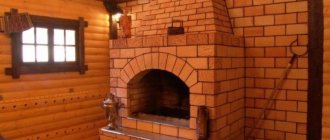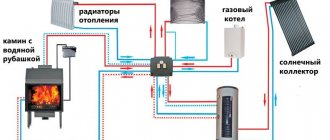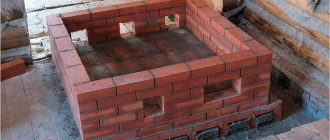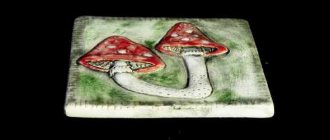To build a fireplace or stove, classic red brick is most often used; its main advantages are durability, reliability, sufficient density, high heat capacity and fire safety. When performing installation work, a special mortar for laying furnaces is used, which is based on special components. The stability and strength of the entire structure depend on how conscientiously and in what proportion they are mixed. Most often, when constructing furnaces, solutions based on clay, cement or lime are used. The last two materials are a more preferable choice if the master has started building a pedestal for the chimney: cement and lime are more durable and resistant to cracks. To ensure that the future structure is stable, solutions for furnaces are prepared in precise proportions, guaranteeing the required plasticity and optimal density.
Important points
The construction of the furnace takes place in several stages, each of which has its own mortar recipe. First, a foundation is made; work on it requires a reliable concrete solution, which is based on cement. After this, the laying of the furnace itself begins; as a rule, refractory bricks are taken for it, and here you cannot do without masonry mortar. Work on a chimney has its own characteristics: the priority is resistance not to high temperatures, but to atmospheric changes, because its installation is carried out not only indoors. The final stage is coating the oven with a plaster solution, the composition also differs from the previously used mixtures.
Of all the stages listed, the greatest attention should be paid to preparing the mortar for the stove masonry. It must meet the following conditions:
- High heat resistance , expressed in the ability to withstand the influence of open flames and maintain a flat surface even under high temperatures.
- Even heat-resistant bricks adhere well to each other , ensuring a minimum seam thickness.
The most commonly used stove mixtures are clay-based, which have been used by stove makers for several centuries. Other stages of furnace construction are characterized by the use of lime-based solutions, as well as mixed ones - with the addition of cement or cement-sand to lime.
Those who want to prepare a solution for stove masonry with their own hands cannot do without such devices as:
- construction mixer;
- pallet or other similar shaped container;
- measuring bucket;
- shovel;
- sieve;
- putty knife;
- Master OK;
- thermometer;
- scales;
- trowel.
Features of furnace construction that influence the choice of solution
The construction of furnace structures has its own characteristics that influence the choice of a particular solution. Let's take a closer look at each stage of construction:
- The foundation is the base of the furnace, and if it fails, it becomes necessary to rebuild the entire furnace structure. During the operation of the furnace, the foundation experiences virtually no thermal loads, so a sand-cement or cement-lime mixture is suitable for its construction. If the structure is large, you can simply use lime mortar for masonry.
- The heat-storing part of the furnace structure, its heating reaches 700 degrees, and it is also exposed to the chemical influence of flue gases, with the formation of acid condensate. For the construction of this site, ordinary clay mortar is used, the quality of which has been tested for centuries.
- The broiler or oven firebox can heat up to 1200 degrees. It is recommended to use a clay-chamotte, fire-resistant masonry mixture.
- The source of the chimney heats up to 300–400 degrees, allowing the use of a clay solution.
- The chimney fluff is the connecting link between the chimney and the ceiling. The edges of the ceiling in this place rest on the fluff, thereby preventing it from sagging. This area requires increased strength, which is achieved by using clay-lime or simply lime mortar.
- There are special requirements for the construction of a chimney located above the roofing, since this area is exposed not only to internal thermal effects, but also to external atmospheric loads and temperature changes. The best option would be to use lime mortar.
Clay mixtures by type and consistency
To prepare it, you need to take clay, red or white, combine it with sand and then add water. It is very important to use only high quality components for the mixture: for example, only calibrated sand is suitable. To clean it from fine gravel and various plant impurities, use a sieve. The same is done with clay, achieving its homogeneity. As a rule, the following proportions are used: 1 part sand and clay, or 2 parts sand and 1 clay. The water in the solution should be approximately ¼ of the amount of clay.
The main criterion for the finished mortar is
its level of fat content , which determines the elasticity and astringent properties of the mixture, and therefore the reliability of the future structure.
It is also worth paying attention to the purity of the water used: it is better if there are fewer minerals in it. Otherwise, stains may appear through the plaster in the future, which will be caused by sufficient mineralization of the liquid. The finished mortar for the stove should be moderately greasy: too soft will lead to the fact that the finished masonry may crack; a thin mortar will not provide the structure with sufficient reliability. The ideal mortar for laying a brick stove is sufficiently elastic , guaranteeing the stability of the structure after drying.
Optimal fat content of clay
To check the fat content of this main component of the masonry mortar, there is an elementary way. You need to take 0.5 liters of clay and mix it with water until the consistency becomes like stiff dough. Then the resulting mass must be thoroughly kneaded and formed into a ball with a diameter of 4–5 cm. When it dries, it must be placed between two planks and squeezed.
If as a result the ball cracks when squeezed halfway, its fat content is high, which means the mixture does not have enough sand. If it disintegrates almost immediately, you need to add clay. In the event that cracks appear when the ball is compressed by a third, the composition of the oven mixture is selected ideally.
To ensure the reliability of the future furnace, the clay solution for laying it must be prepared from thoroughly cleaned components and have normal or high fat content.
The obvious advantage of the solution, the ingredients of which are carefully selected and dosed, is that the masonry will have a neat appearance due to the thin seam. In addition, a stove mixture of normal fat content will provide the structure with sufficient reliability and durability. True, such a solution still has one drawback: such a solution is not resistant to environmental humidity.
Clay mortar: mixing technology
You need to start by leaving the clay, cleared of impurities, in water for about a day. Then you need to add a little more liquid to it, achieving homogeneity of the mass. The consistency of the mixture for stoves and fireplaces should be similar to thick sour cream. After straining, you need to add sand until the oven mixture becomes viscous. To give the solution strength, you cannot do without cement and salt. The required quantity of these components is 700–750 g and 200 g per bucket, respectively.
Adhesive for tiling stoves - manufacturers
Mari (brands) are popular among professionals and ordinary users:
Ceresit CM 16 Ceresit CM 16 Elastic tile adhesive “Flex” (Ukraine, under German license, 600 rub./pack). Ceresit Flex is designed for installation on complex deformable substrates, as well as using the tile-on-tile method.
Glue “Terracotta” Reinforced heat-resistant glue “Terracotta” (Russia, 550 RUR/pack). Used for cladding with natural stone and terracotta ceramic tiles. Chamotte kaolin dust added to the adhesive solution makes it possible to perform cladding without lining the furnace and obtain an identical result. Operating temperature up to 250 °C. Glue SCANMIX FireSCANMIX Fire (Finland, 600 RUR/pack) has a high softening temperature – 1,200 °C. Scanmix is indispensable for lining furnace outlets and solid fuel stoves. The solution is intended for laying and repairing stoves, as well as for laying tiles on simple surfaces.
Plitonit SuperFireplace Plitonit SuperFireplace (Russia, 455 RUR/pack) allows you to lay the mortar in a thin layer due to the presence of fine-grained fillers. Permissible temperature of use is up to 1,200 °C.
Tile adhesive Ivsil TermixIvsil Termix (Russia, 460 RUR/pack). Highly elastic adhesive. Operating temperature up to 250 °C, which allows it to be used on stove surfaces away from the firebox and on fireplaces with a closed firebox. Ivsil Thermix adhesive is intended for durable substrates.
Tile adhesive “Pechnik”Glue “Pechnik” (Belarus, 260 RUR/20 kg). Maximum operating temperature up to 250 degrees Celsius.
Glue for stove tiles Bergauf KERAMIK TERMOBergauf KERAMIK TERMO (Yunis, Russia, 450 RUR/pack). Bergauf Ceramic Thermo glue is used for simple surfaces with heating temperatures up to + 180 °C.
Glue SILTEK T-84SILTEK T-84 (Ukraine, 360 RUR/pack). Siltek adhesive is used for cladding surfaces exposed to temperature changes within the range of – 30°C – +150°C.
Mortar for stove masonry according to all the rules
As already noted, its ideal consistency should correspond to the thickness of sour cream. If you use oily clay for it, then you need to add 2 parts of sand to 1 part; if it’s normal, the proportion should be equal.
Before starting to lay the stove, it is necessary to check the quality of the resulting stove mixture. To do this, you will need to fasten 2 bricks with mortar, wait about 5 minutes, and then lift the top brick. If the structure does not fall apart after several lifts, the mortar for laying a brick stove is ideal. If this did not happen and the adhesion quickly disintegrated, most likely, lean (non-greasy) clay was used to prepare the solution.
Experienced stove makers also advise increasing the strength of the solution by adding table salt to it (150 g is enough for 10 kg of clay). You can also add M400 cement: 1 kg for the same volume of clay.
When the stage of work on the chimney begins, it would be better to replace the clay mortar with lime-sand mortar: it is more resistant to moisture. To prepare it you need to take 3 parts sand and 1 part lime dough. Alternatively, use 1 part quicklime and 3 parts water.
What tools will you need?
Before you start preparing solutions, you need to select a tool:
- a kneading oar (a specially hewn board with a handle);
- shovel;
- container for mixing the solution (a wooden trough or barrel, or a metal container);
- 5-6 buckets;
- trowel, which determines plasticity;
- a pair of metal sieves with 3x1.5 mm cells;
After the tool is prepared, you will need to prepare the components for the solution.
Cement as a base for mortar
To build a furnace foundation, the solution must be selected in such a way as to ensure reliability and stability of the structure, and cement is best suited for these purposes . This mixture is also suitable for the construction of that part of the chimney that will rise above the roof. The composition of the solution is cement, sand and water. Most often, the proportions used are: 1 part M300 or M400 cement and 3 parts sand. The components must be mixed well and diluted with water until the consistency of sour cream. The resulting mixture for laying stoves should be moveable, but not flow off the bayonet of the shovel if it is located at an angle of 45 degrees.
For the foundation and bottom of the combustion chamber, you will need a stove mixture with good heat resistance. Here is its composition: for 1 part of portlant cement M300 or M400 take 0.3–0.5 parts of fireclay sand and 2 each of finely sifted sand and crushed stone (gravel is also suitable).











